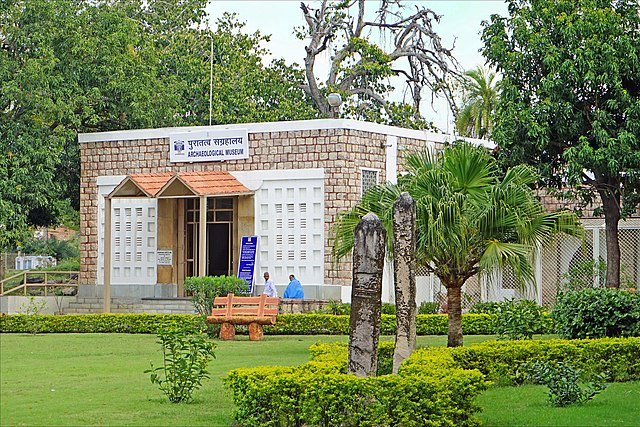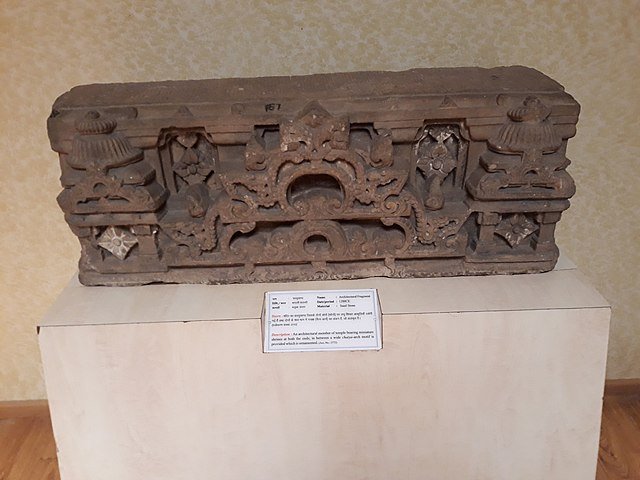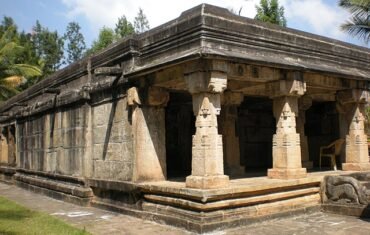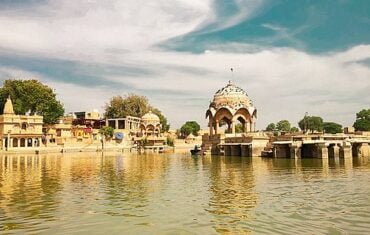Sanchi Archeological Museum is a museum near the archeological site of Sanchi, which is famous for its ancient Buddhist monuments, such as stupas, temples, and monasteries. The museum houses various artifacts that were found during the excavations at Sanchi and its surrounding areas. The museum was established in 1919 by Sir John Marshall, the then director of the Archeological Survey of India. The museum showcases the history and culture of Sanchi and its significance in the development of Buddhism in India and beyond. Visit during One Day Bhopal to Sanchi-Udaigiri Trip by cab
Overview of Sanchi Archeological Museum

Sanchi Archeological Museum is located on a hilltop, overlooking the Sanchi Stupa complex. The museum consists of a main hall and four galleries, besides a verandah and a few open courtyards. The museum displays objects that belong to different periods of Indian history, ranging from the 3rd century BCE to the 12th century CE. The objects include sculptures, coins, pottery, inscriptions, seals, terracotta, and metal objects. The museum also has a section on the history and culture of Bhopal and its people. The museum aims to provide information and education on the archeology, art, and architecture of Sanchi and its vicinity. Best 10 Places To Visit in Bhopal
Location of Sanchi Archeological Museum
Sanchi Archeological Museum is situated on the NH-86, near the Sanchi Stupa, in the district of Raisen, Madhya Pradesh, India. The museum is about 46 km from the Bhopal Railway Station and 55 km from the Raja Bhoj Airport. The museum is easily accessible by public transport, such as buses, taxis, and auto-rickshaws.
Timing/Entry Fees Sanchi Archeological Museum

Sanchi Archeological Museum is open to the public from 10:00 am to 5:00 pm, from Tuesday to Sunday. The museum is closed on Mondays and public holidays. The entry fee for the museum is Rs. 10 for Indian visitors and Rs. 100 for foreign visitors. There is no entry fee for children below 12 years, students, and senior citizens. There is an additional fee of Rs. 10 for photography and Rs. 20 for videography. The museum also offers guided tours and audio guides for a nominal charge.
How to Reach Sanchi Archeological Museum

Sanchi Archeological Museum can be reached by various modes of transport from different parts of Bhopal and other nearby cities. Some of the options are:
- By Bus: There are several buses that ply to Sanchi Archeological Museum from various bus stops in Bhopal and other cities, such as Vidisha, Raisen, and Sagar. The nearest bus stop to the museum is the Sanchi Bus Stop, which is about 500 meters away.
- By Taxi: Taxis are another convenient way to reach Sanchi Archeological Museum from anywhere in Bhopal and other cities. The fare depends on the distance and the traffic conditions, but it usually ranges from Rs. 500 to Rs. 1000. One can also book a taxi online or through a mobile app, such as Ola, Uber, or Meru.
- By Auto-Rickshaw: Auto-rickshaws are the most common and affordable mode of transport in Bhopal and other cities. They can be hailed from any street corner or stand, and they charge according to the meter or by bargaining. The average fare to Sanchi Archeological Museum from Bhopal is around Rs. 300 to Rs. 500.
Things to Do Sanchi Archeological Museum

Sanchi Archeological Museum is a place where one can experience the history and culture of Sanchi and its surroundings. There are many things to do and see in and around the museum, such as:
- Explore the museum and admire its architecture, design, and decor. See the various exhibits and displays, and learn about their history and significance. Marvel at the diversity and unity of Indian culture and civilization, and the achievements and challenges of Sanchi and its monuments.
- Enjoy the view and the nature. Take a walk around the museum, which offers a panoramic view of the Sanchi Stupa complex and the surrounding landscape. Watch the sunrise and sunset from the museum terrace, which is a popular spot for photography and meditation. Relax in the lawns and gaze at the fountains and ponds. Watch the birds and animals that inhabit the museum premises.
- Visit the Sanchi Stupa complex and other nearby attractions. The Sanchi Stupa complex is a UNESCO World Heritage Site, and consists of several stupas, temples, monasteries, and pillars, dating back to the 3rd century BCE to the 12th century CE. The complex is a testimony to the spread and development of Buddhism in India and beyond. The complex also has a museum, which displays some of the relics and sculptures found in the site. Other nearby attractions include the Udayagiri Caves, the Ashoka Pillar, the Bhojpur Temple, and the Bhimbetka Rock Shelters.
Significance of Sanchi Archeological Museum
Sanchi Archeological Museum is not only a tourist attraction, but also a symbol of the heritage and identity of Sanchi and its vicinity. The museum represents the vision and mission of Sir John Marshall, who was the pioneer of the archeological exploration and conservation of Sanchi and its monuments. The museum also reflects the cultural diversity and harmony of Sanchi and its vicinity, which has been influenced by various regions and religions over the centuries. The museum is a source of pride and inspiration for the people of Sanchi and its vicinity, who cherish and preserve its beauty and value.
FAQ’s
Here are some of the frequently asked questions about Sanchi Archeological Museum:
Q: When was Sanchi Archeological Museum established?
A: Sanchi Archeological Museum was established in 1919 by Sir John Marshall, the then director of the Archeological Survey of India.
Q: Who is Sir John Marshall?
A: Sir John Marshall was a British archeologist and civil servant, who was the director of the Archeological Survey of India from 1902 to 1928. He was responsible for the discovery and excavation of many important sites in India, such as Harappa, Mohenjo-daro, Taxila, and Sanchi. He was also instrumental in the preservation and restoration of many monuments, such as the Taj Mahal, the Qutub Minar, and the Ajanta Caves.
Q: What are the main attractions of Sanchi Archeological Museum?
A: The main attractions of Sanchi Archeological Museum are its exhibits and displays, which include sculptures, coins, pottery, inscriptions, seals, terracotta, and metal objects. The museum also has a section on the history and culture of Bhopal and its people.
Q: What is the timing and entry fee of Sanchi Archeological Museum?
A: Sanchi Archeological Museum is open to the public from 10:00 am to 5:00 pm, from Tuesday to Sunday. The museum is closed on Mondays and public holidays. The entry fee for the museum is Rs. 10 for Indian visitors and Rs. 100 for foreign visitors. There is no entry fee for children below 12 years, students, and senior citizens. There is an additional fee of Rs. 10 for photography and Rs. 20 for videography.
Conclusion
Sanchi Archeological Museum is a must-see destination for anyone who visits Sanchi and its surroundings. It is a place where one can witness the history and culture of Sanchi and its vicinity. It is a place where one can learn about the vision and mission of Sir John Marshall and his contribution to Sanchi and its monuments. It is a place where one can enjoy the view and the nature of the museum and its surroundings. It is a place where one can visit the Sanchi Stupa complex and other nearby attractions. Sanchi Archeological Museum is a place that offers something for everyone, and leaves a lasting impression on the visitors.










